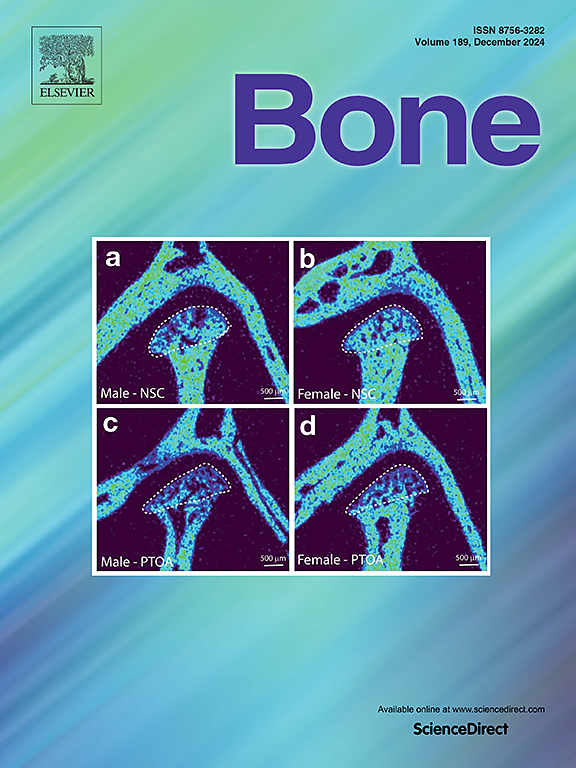LncRNA H19 promotes osteoclast differentiation by sponging miR-29c-3p to increase expression of cathepsin K
IF 3.5
2区 医学
Q2 ENDOCRINOLOGY & METABOLISM
引用次数: 0
Abstract
Background
Osteoporosis is a prevalent metabolic bone disease. Osteoporotic fractures can lead to severe functional impairment and increased mortality. Long noncoding RNA H19 has emerged as a pivotal player in bone remodeling, serving both as a biomarker and a regulator. While previous research has elucidated H19's role in promoting osteogenic differentiation through diverse mechanisms, its involvement in osteoclast differentiation remains largely unknown.
Methods
In this study, we used lentiviral vectors to stably overexpress or knockdown H19 in RAW264.7 cell lines. Quantitative reverse polymerase chain reaction, Western blot, tartrate resistant acid phosphatase staining and bone resorption assay were performed to assess the level of osteoclast differentiation and bone resorption capacity. And fluorescence in situ hybridization, dual-luciferase reporter and RNA immunoprecipitation were used to explore the specific mechanism of H19 regulating osteoclast differentiation in vitro. Then, ovariectomized osteoporosis models in wild type mice and H19 knockout mice were conducted. And micro-CT analysis, HE staining, and immunohistochemistry were performed to verify the mechanism of H19 regulating osteoclast differentiation in vivo. Bone marrow derived monocytes and bone mesenchymal stem cells were extracted from mice and assayed for osteoclastic and osteogenic-related assays, respectively.
Results
In vitro, H19 promoted osteoclast differentiation and bone resorption of RAW264.7 cells, while miR-29c-3p inhibited them. Both H19 and cathepsin K were the target genes of miR-29c-3p. In vivo, H19 knockout mice have increased femur bone mineral density, decreased osteoclast formation, and reduced cathepsin K expression. MiR-29c-3p agomir could increase bone mineral density in osteoporotic mice on the premise of H19 knockout.
Conclusions
H19 upregulates cathepsin K expression through sponging miR-29c-3p, which promoting osteoclast differentiation and enhancing bone resorption. This underscores the potential of H19 and miR-29c-3p as promising biomarkers for osteoporosis.
LncRNA H19通过海绵miR-29c-3p增加组织蛋白酶K的表达,促进破骨细胞分化
背景:骨质疏松症是一种常见的代谢性骨病。骨质疏松性骨折可导致严重的功能损害和死亡率增加。长链非编码RNA H19作为生物标志物和调节因子在骨重塑中发挥着关键作用。虽然先前的研究已经阐明了H19通过多种机制促进成骨分化的作用,但它在破骨细胞分化中的作用仍然很大程度上未知。方法采用慢病毒载体在RAW264.7细胞株中稳定过表达或低表达H19。采用定量反聚合酶链反应、Western blot、抗酒石酸酸性磷酸酶染色及骨吸收法检测破骨细胞分化水平及骨吸收能力。采用荧光原位杂交、双荧光素酶报告基因和RNA免疫沉淀等方法探讨H19在体外调节破骨细胞分化的具体机制。然后建立野生型小鼠和H19敲除小鼠去卵巢骨质疏松模型。通过显微ct、HE染色、免疫组化等方法验证H19在体内调节破骨细胞分化的机制。从小鼠身上提取骨髓来源的单核细胞和骨间充质干细胞,分别进行破骨和成骨相关的实验。结果在体外,H19促进RAW264.7细胞的破骨细胞分化和骨吸收,而miR-29c-3p对其有抑制作用。H19和组织蛋白酶K都是miR-29c-3p的靶基因。在体内,H19基因敲除小鼠股骨骨密度增加,破骨细胞形成减少,组织蛋白酶K表达降低。MiR-29c-3p agomir可以在敲除H19的前提下增加骨质疏松小鼠的骨密度。结论sh19通过海绵miR-29c-3p上调cathepsin K的表达,促进破骨细胞分化,增强骨吸收。这强调了H19和miR-29c-3p作为骨质疏松症有希望的生物标志物的潜力。
本文章由计算机程序翻译,如有差异,请以英文原文为准。
求助全文
约1分钟内获得全文
求助全文
来源期刊

Bone
医学-内分泌学与代谢
CiteScore
8.90
自引率
4.90%
发文量
264
审稿时长
30 days
期刊介绍:
BONE is an interdisciplinary forum for the rapid publication of original articles and reviews on basic, translational, and clinical aspects of bone and mineral metabolism. The Journal also encourages submissions related to interactions of bone with other organ systems, including cartilage, endocrine, muscle, fat, neural, vascular, gastrointestinal, hematopoietic, and immune systems. Particular attention is placed on the application of experimental studies to clinical practice.
 求助内容:
求助内容: 应助结果提醒方式:
应助结果提醒方式:


